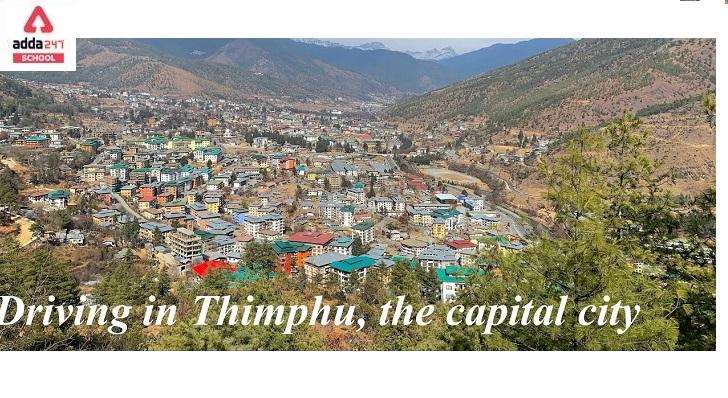The capital of Bhutan is Thimpu, which is also the largest city in Bhutan.
Thimpu is located in Bhutan’s western-central region. Thimpu District, one of Bhutan’s dzongkhags, including the surrounding valley of Thimpu. In 1955, Thimphu took the place of Punakha as the country’s capital. Thimphu was designated as the capital of Bhutan by the 3rd Druk Gyalpo Jigme Dorji Wangchuck in 1961.
Capital of Bhutan Name
The city is located on the west side of the Raidāk River valley, which runs north-south. In Bhutan, the Raidk River is known as the Wang Chuu or Thimphu Chuu. Thimphu is the world’s fifth-highest capital, with elevations ranging from 7,375 feet to 8,688 feet.
Thimphu does not have its own airport, which is quiet for Thimpu being a capital city.
Capital of Bhutan Location
Thimpu, Bhutan’s capital, is served by the Paro Airport, which is 52 kilometres distant by road. Bhutan’s political and economic capital, Thimphu, has a strong agricultural and cattle basis. The agricultural and livestock sectors account for 45 per cent of the country’s gross domestic product. Although tourism is beneficial to the economy, it is closely regulated in order to maintain a balance between tradition, development, and modernization.
The majority of Bhutan’s main political structures are located in Thimphu. Thimphu is governed by the “Thimphu Structure Plan,” an urban development plan developed in 1998 with the goal of safeguarding the valley’s fragile nature. The World Bank and the Asian Development Bank are providing financial support for this project.
Bhutanese culture is vividly portrayed in Thimphu. Thimpu is one of the ideal capital cities and for Bhutan, whether it’s in literature, religion, customs, and national dress code, monastic rituals, music, and dance, or the media. Tshechu is a significant celebration that features mask dances, often known as Cham dances. Tshechu is a traditional Bhutanese dance performed in the courtyards of Thimphu’s Tashichho Dzong. Every year in September or October, on dates that correlate to the Bhutanese calendar, this four-day event is held.
Capital of Bhutan is Thimpu: Geography
The city is situated between 7,375 and 8,688 feet above sea level. The valley, on the other hand, is sparsely vegetated and sprawls out to the north and west.
Thimphu is located in the Raidāk River’s constrained, linear valley. The Raidāk River rises in the snowfields and has numerous tributaries that flow from Himalayan hills, dictating the Thimphu valley’s structure. A strong eastern ridge rising from the riverbed and a valley formation with gently decreasing topography define the Thimphu valley.
The city has a subtropical highland climate affected by the southwest monsoon. From mid-April until September, the southwest monsoon rains fall. Rainfall in the region is frequently preceded by lightning and thunder, with cumulonimbus clouds and light showers dominating the weather. Rainfall continues for several days, resulting in landslides and road closures. Winter weather in Thimpu is marked by cold winds, low temperatures at night, and mild temperatures during the day, cloudiness, light showers, and snowfall. The terrain is defined by fierce gusts and reasonably dry and clear skies as spring approaches.
Capital of Bhutan in Hindi (Bhutan ki Rajdhani)
भूटान की राजधानी थिंपू है, जो भूटान का सबसे बड़ा शहर भी है।
थिम्पू भूटान के पश्चिमी-मध्य क्षेत्र में स्थित है। थिम्पू जिला, भूटान के ज़ोंगखगों में से एक, जिसमें थिम्पू की आसपास की घाटी भी शामिल है। 1955 में, थिम्पू ने देश की राजधानी के रूप में पुनाखा की जगह ली। 1961 में तीसरे ड्रुक ग्यालपो जिग्मे दोरजी वांगचुक द्वारा थिम्पू को भूटान की राजधानी के रूप में नामित किया गया था।
यह शहर रैडक नदी घाटी के पश्चिम में स्थित है, जो उत्तर-दक्षिण में चलती है। भूटान में रैडक नदी को वांग चुउ या थिम्फू चुउ के नाम से जाना जाता है।
थिम्पू का अपना हवाई अड्डा नहीं है, जो थिम्पू की राजधानी होने के कारण शांत है। भूटान की राजधानी थिम्पू में पारो हवाई अड्डा है, जो सड़क मार्ग से 52 किलोमीटर दूर है।
भूटान की राजनीतिक और आर्थिक राजधानी, थिम्पू, का कृषि और पशु आधार मजबूत है। देश के सकल घरेलू उत्पाद में कृषि और पशुधन क्षेत्र का योगदान 45 प्रतिशत है। हालांकि पर्यटन अर्थव्यवस्था के लिए फायदेमंद है, लेकिन परंपरा, विकास और आधुनिकीकरण के बीच संतुलन बनाए रखने के लिए इसे बारीकी से नियंत्रित किया जाता है। भूटान की अधिकांश मुख्य राजनीतिक संरचनाएँ थिम्पू में स्थित हैं। नव स्थापित संसदीय लोकतंत्र की राष्ट्रीय सभा, साथ ही राजा के औपचारिक निवास, डेचनचोलिंग पैलेस, दोनों शहर के उत्तर में स्थित हैं। थिम्पू “थिम्पू स्ट्रक्चर प्लान” द्वारा शासित है, जो कि घाटी की नाजुक प्रकृति की सुरक्षा के लक्ष्य के साथ 1998 में विकसित एक शहरी विकास योजना है। विश्व बैंक और एशियाई विकास बैंक इस परियोजना के लिए वित्तीय सहायता प्रदान कर रहे हैं।
थिम्पू में भूटानी संस्कृति को विशद रूप से चित्रित किया गया है। थिम्पू आदर्श राजधानी शहरों में से एक है और भूटान के लिए, चाहे वह साहित्य, धर्म, रीति-रिवाजों और राष्ट्रीय ड्रेस कोड, मठ के अनुष्ठानों, संगीत और नृत्य, या मीडिया में हो। त्शेचु एक महत्वपूर्ण उत्सव है जिसमें मुखौटा नृत्य होते हैं, जिन्हें अक्सर चाम नृत्य के रूप में जाना जाता है। त्शेचु एक पारंपरिक भूटानी नृत्य है जो थिम्फू के ताशिचो द्ज़ोंग के प्रांगण में किया जाता है। हर साल सितंबर या अक्टूबर में, भूटानी कैलेंडर से संबंधित तिथियों पर, यह चार दिवसीय आयोजन आयोजित किया जाता है।









 CUET UG Final Answer Key 2025 Revised, D...
CUET UG Final Answer Key 2025 Revised, D...
 DU Cut off 2025, Delhi University Expect...
DU Cut off 2025, Delhi University Expect...
 OUAT Result 2025 OUT @ouat.nic.in: Check...
OUAT Result 2025 OUT @ouat.nic.in: Check...









